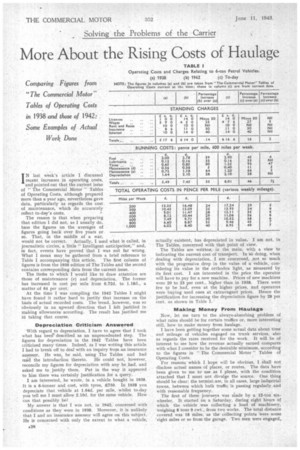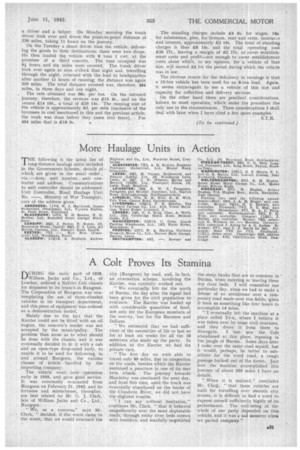More About the Rising Costs of Haulage
Page 30

Page 33

If you've noticed an error in this article please click here to report it so we can fix it.
Comparing Figures from "The Commercial MotorTables of Operating Costs in 1938 and those of 1942: Some Examples of Actual
Work Done
IN last week's article I discussed recent increases in operating costs, and pointed out that the current issue of " The Commercial Motor " Tables of Operating Costs, although prepared more than a year ago, nevertheless gave data, particularly as regards the cost of maintenance, which do accurately reflect to-day's costs.
The reason is that when preparing that edition I did not, as I usually do, base the figures on the averages of figures going back over five years or
so. That, in the middle of a war.•
would not be correct. Actually, I used what is called, in journalistic circles, a little " Intelligent anticipation," and, in fact, events have proved that I was not far wrong. What I mean may be gathered from a brief reference to Table I accompanying this article. The first column of figures is from the 1938 edition of The Tables and the second contains corresponding data from the current issue.
The items to which I would like to draw attention are those of maintenance (e) and depreciation. The former has increased in cost per mile from 0.72d. to 1.18d., a matter of 64 per cent.
At the time I was compiling the 1942 Tables I might have found it rather hard to justify that increase on the basis of actual recorded costs. The trend, however, was so obviously in an -upward direction that I felt justified in making allowances according. The result has justified me in taking that course.
Depreciation Criticism Answered
With regard to depreciation. I have to agree that I took what has been" described as an unprecedented step. The figures for depreciation in the 1942 Tables have been criticized many times. Indeed, as I was writing this article I had to break off to deal with an inquiry from an insurance assessor. He WaS, he said, using The Tables and had read the introduction thereto. He could not, however, reconcile my figures for depreciation with any he had, and asked me to , justify them. Put in the way it appeared
to him there was certainly justification for a query. • I am interested, he wrote, in a vehicle bought in 1938. It is a 6-tonner and cost, with tyres, £750. In 1938 you depreciate that vehicle at 1.64d. per mile, whilst to-day you tell me I must allow 2.10d. for the same vehicle. How can that possibly be?
My answer is that I was not, in 1942, concerned with conditions as they were in 1938'. Moreover, it is unlikely that I and an insurance assessor will agree on this subject. He is concerned with only the extent to what a vehicle,
actually existent, has depreciated in value. I am not, in The Tables, concerned with that point of view.
The Tables are writteu, in the main, with a view to indicating the current cost of transport. In so doing, when dealing with. depreciation, I am concerned, not so much with the progressive drop in the value of a vehicle, considering its value in the orthodox light, as measured by its first cost. I am interested in the price the operator will have to pay for a new machine. Prices of new machines were 20 to 25 per cent., higher than in 1938. There were few to be had, even at the higher prices, and operators were buying used ones at extravagant prices. Hence the justification for increasing the depreciation figure by 28 per cent, as shown in Table I.
Making Money From Haulage
Now, let me turn to the always-absorbing problem of what rates should be for certain traffics or, more interesting' still, how to make money from haulage.
I have been getting together some actual data about time and mileage of vehicles engaged on trunk services, also as regards the rates received for the work. It will be of interest to see how the revenue actually earned compares with what I consider to be the desirable minimum, according to the figures in "The Commercial Motor " Tables of Operating Costs. For reasons which I hope will be obvicius, I shall not disclose actual names of places, or routes. The data have been given to me to use as I please, with the condition attached that I must not divulge the source. One thing should be clear: the termini are, in all cases, large indastrial towns, between which bulk traffic is passing regularly and with reasonable frequency.
The first of these journeys was Made by a 12-ton sixwheeler. It started on a Saturday, during eight hours of which the vehicle was collecting a load of machinery, weighing 8 tons 9 cwt., from two works, The total distance covered was 18 miles, as the collecting points were some -eight miles or so from the garage. Two men were engaged,
a driver and a helper. On Monday morning the trunk driver took over and drove the point-to-point distance of 230 miles, taking 11 hours on the journey.
On the Tuesday a shunt driver took the vehicle, delivering the goods to their destinations; there were two drops. He then loaded the vehicle with 8 tons 1 cwt. at the premises of a third concern. The time occupied was 94 hours and six miles were covered. The trunk driver took over again at nine o'clock that night and, travelling through the night, returned with the load to headquarters after another 11 hours of running; the distance was again 230 miles. The total distance covered was, therefore, 484 miles, in three days and one night.
The rate obtained was 36s. per ton. On the outward journey, therefore, the revenue was £15 4s., and on the return £14 10s., a total of £29 14s. The running cost of the vehicle is approximately 9d. per mile (exclusive of the increases in cost-mentioned in this and the previous article: the work was done before they came into force). For
484 miles that is £18 3s. • The standing charges include £4 6s. for wages, las. for subsistence, phis, for licences, rent and rates, insurance and interest, approximately £3 10s. The total of standing charges is thus £8 14s. and the total operating cost £26 17s., leaving a margin of £2 17s. to cover establishment costs and profit—not enough to cover establishment costs alone which, in my opinion, for a vehicle of that size, will exceed £4 for the period during Which the vehicle was in use.
The obvious reason for the deficiency in 'earnings is that a 12-ton vehicle has been used for an 8-ton load. Again, it seems extravagant to use a vehicle of this size and -capacity for collection and delivery services.
, On the other hand there arc practical considerations, known to most operators, which make the procedure the only one in the circumstances. These considerations I shall deal with later when I have cited a few more examples.
S.T.R.




















































